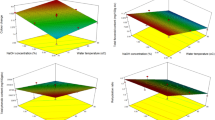Abstract
ONE of the staple foods of the people of the rain forest belt of West Africa is gari, a starchy food prepared from the root of the cassava plant (Manihot utilissima). The traditional preparation of gari1 consists briefly of the following stages: both the corky outer peal and the thick cortex are removed; the body of the root is grated by hand on home-made raspers; the greater part of the juice is removed from the pulp by primitive pressing; the pulp is left in bags for 72–96 hr. before it is fried. During this time fermentation occurs; hand-made raffia fabrics are used for ‘sifting’. A certain amount of fibre and ungrated ends of the roots are removed here. The pulp is afterwards heated in large iron pans over an open fire with or without the addition of palm oil.
This is a preview of subscription content, access via your institution
Access options
Subscribe to this journal
Receive 51 print issues and online access
$199.00 per year
only $3.90 per issue
Buy this article
- Purchase on Springer Link
- Instant access to full article PDF
Prices may be subject to local taxes which are calculated during checkout
Similar content being viewed by others
References
Vignoli and Cristau, “Cahiers Coloniaux” No. 8, 303 (October 1950).
Quoted in B.I.I., 1, 15 (1903).
B.I.I., 1, 15 (1903).
Dunstan, Henry and Auld, Proc. Roy. Soc., B, 78, 152 (1906).
Oyenuga and Amazigo, West African J. Biol. Chem., 1, 39 (1957).
Author information
Authors and Affiliations
Rights and permissions
About this article
Cite this article
COLLARD, P., LEVI, S. A Two-Stage Fermentation of Cassava. Nature 183, 620–621 (1959). https://doi.org/10.1038/183620a0
Issue Date:
DOI: https://doi.org/10.1038/183620a0
This article is cited by
-
Effect of traditional processing of cassava on the cyanide content of gari and cassava flour
Plant Foods for Human Nutrition (1995)
-
Microbiology of pozol, a Mexican fermented maize dough
World Journal of Microbiology & Biotechnology (1995)
-
The effect of fermentation on the nutrient status and on some toxic components ofIcacinia manni
Plant Foods for Human Nutrition (1992)
-
Suitability of using sieved or unsieved maize mash for production of “OGI” — A fermented cereal food
Plant Foods for Human Nutrition (1992)
-
Characterization ofgari andfu-fu preparation procedures in Nigeria
World Journal of Microbiology and Biotechnology (1992)
Comments
By submitting a comment you agree to abide by our Terms and Community Guidelines. If you find something abusive or that does not comply with our terms or guidelines please flag it as inappropriate.



